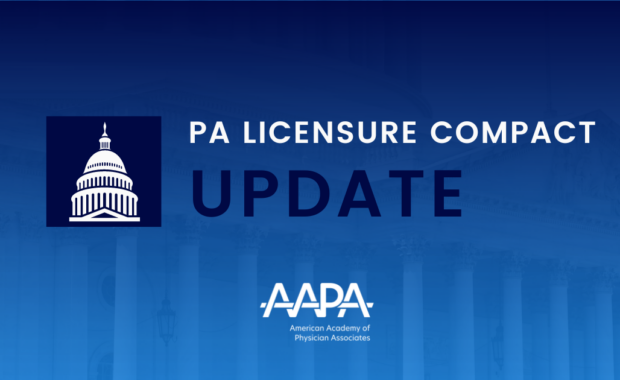Common Questions About Treating Patients with Dementia Experiencing Neuropsychiatric Symptoms
About 6.9 million Americans are living with Alzheimer’s Disease
March 28, 2025

Physician associates are frontline providers, practicing in every medical setting and specialty across the country. This makes PAs very likely to treat patients with dementia experiencing neuropsychiatric symptoms (NPS), especially as the patient population ages and rates of Alzheimer’s Disease (AD) increase.
Amy Klingler, PA-C, practices in rural primary care and often treats patients with dementia. Below, she has answered some of the most frequently asked questions about dementia with NPS in order to help PAs feel better prepared to work with this patient group.
More resources are also available in AAPA’s Neuropsychiatric Symptoms Associated with Alzheimer’s Toolkit.
What are the NPS of AD? How common are they, and what is their impact on quality of life and prognosis?
Klingler: Key NPS of AD are apathy, agitation, aggression, depression/anxiety, sleep disorders, and psychosis (hallucinations and/or delusions). While sometimes subtle in early stages, NPS can be the first sign of AD, before cognitive and memory changes are evident. NPS can have a significant impact on quality of life for patients and can also create more challenges for their care partners (the people who help them with health and well-being). As they progress, NPS can cause increased morbidity and mortality and, if they cannot be managed, can result in earlier placement in long-term care facilities. About 6.9 million Americans are living with AD, the vast majority of whom are over the age of 75.
What is the recommended treatment strategy for managing NPS in patients with Alzheimer’s disease? And is it typically under the purview of the primary care or specialty provider?
Klingler: The first step in managing NPS is addressing basic needs with nonpharmacologic interventions. We ensure patients maintain adequate hydration and are eating regularly. We try to focus on good sleep hygiene and adequate rest. Developing and maintaining routines so patients have consistency, and practicing distraction and de-escalation techniques, are also ways to address NPS.
Many of the medications that are used to treat NPS have contraindications in the elderly, so we use them as a last resort. I have used SSRIs and try to avoid tricyclic antidepressants and benzodiazepines. Antipsychotics, particularly second generation, can be used, but it is important to remember it is off label and to monitor patients closely for side effects. When patients need medications to manage NPS, I find it helpful to consult with neurology colleagues.
How do you tackle the sensitive issues surrounding whether a patient is fit to continue driving?
Klingler: Driving is one of the more difficult conversations providers and families have with patients with AD. It is important to note that different states have different reporting requirements for patients with AD, so PAs should know their state laws. It is also important to remember that healthcare providers do not make the final decisions about driving privileges, but their input may be required by state motor vehicle departments.
Patients may be more likely to listen to the concerns a PA has about their driving than a family member. I like to rely on objective findings such as medications or health conditions that can impact the ability to drive, alertness, and reaction time. We review the driving history and any recent accidents (including minor fender-benders), and refer for driving assessments. Individuals in the early stages of AD can usually continue to drive safely, however, those with moderate or advanced AD should not drive. Because the loss of driving privileges is a loss of independence of patients, it can be helpful to connect them with community resources for transportation, grocery shopping/delivery, and other needs that are important to them.
Note: All patients with AD will need to stop driving as they progress to at least moderate disease.
How can you help prepare care partners optimally manage NPS—particularly anxiety or agitation—that occur outside the home setting, like in a restaurant, clinic, or hospital?
Klingler: Helping care partners identify and manage NPS, such as agitation and anxiety, in or out of the home is critical. The first step as always is making sure basic needs are met. Is the patient hungry or thirsty? Exhausted? Hot or cold? In a new or chaotic environment? Address those needs first. Distraction and calming techniques such as reorienting, removing them from a frustrating situation, and talking and explaining things in a calm, non-judgmental manner can help de-escalate the situation.
What are the challenges providers face when billing for management of NPS of AD?
Klingler: Visits to discuss NPS of AD are often time consuming and, ideally, involve input from patients and care partners. This can be difficult to manage in a busy practice. Utilizing members of the clinical team such as nursing staff and medical assistants to administer screening tools and assess the status of the patient care partner’s primary concerns can help streamline the appointments. Time-based coding can be helpful, but it is important to document time as required by Medicare or other insurers. Documenting the complexity of caring for the whole patient by including comorbidities can support higher levels of CPT coding.
For more resources and in-depth information about treating patients with dementia experiencing NPS, visit AAPA’s Neuropsychiatric Symptoms Associated with Alzheimer’s Toolkit.
You May Also Like
AAPA’s Neuropsychiatric Symptoms Associated with Alzheimer’s Toolkit
Cognitive Assessment Toolkit
AAPA Awarded Grant from Exact Sciences to Improve Colorectal Cancer Screening Rates
Thank you for reading AAPA’s News Central
You have 2 articles left this month. Create a free account to read more stories, or become a member for more access to exclusive benefits! Already have an account? Log in.



